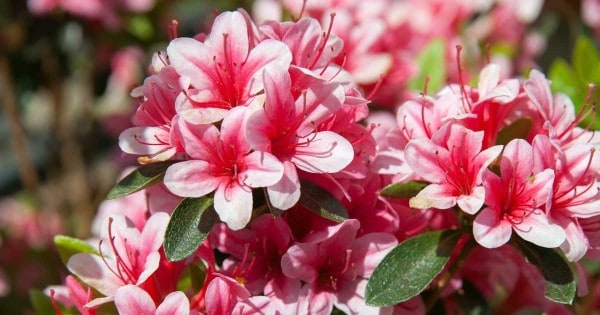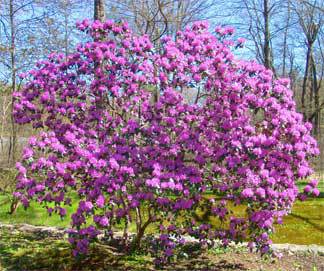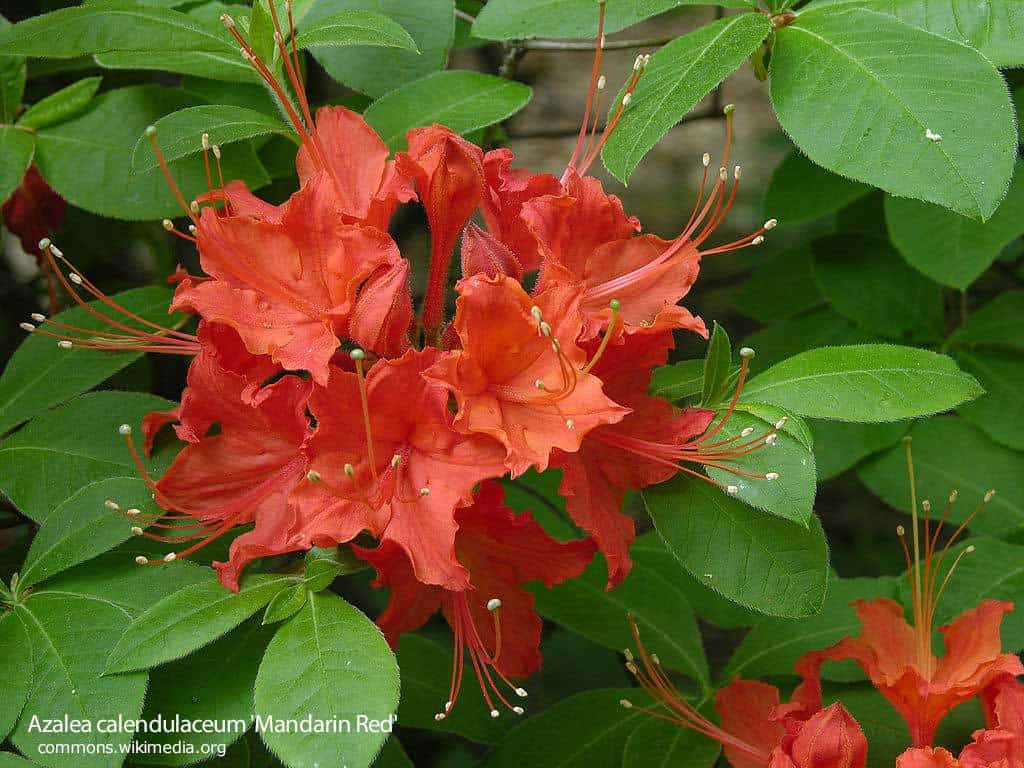Summary: Azalea plants are excellent and brilliant landscape plants. Growing azaleas is not difficult – easy to grow, easy to propagate, and easy to transplant.
Flowering Azalea bushes in late Spring
Question: We have heard azalea plants are good plants to start with in our landscape. How difficult is planting azaleas and to grow and care for? Marisa, Corvallis, Oregon
Answer: Marisa, azalea plants are excellent plants for the landscape.
Many people scratch their head wondering what plants to choose for their landscape. Azaleas are a great first choice.
Azalea flowers remain attractive. In full bloom these flowering shrubs are gorgeous. They are:
- Permanent
- Inexpensive
- Easy to care for
- Easy to propagate
- Easy to transplant
All pro and no con!
In our garden beds, azaleas have taken over more and more of the available space. We did not plan it that way. But, azaleas have proved to satisfactory we wanted larger plantings of them.
Azaleas seemed to offer everything we wanted in spring blooming. They provide all-year-round-attractive plants, so we kept buying and propagating more. They’ve become the feature attraction of our garden.
Two Kinds Of Azalea Bushes
What is an Azalea?
Azaleas are of two kinds, deciduous azaleas and evergreen azaleas.
In the colder parts of the country the evergreen varieties lose at least part of their foliage.
I prefer these so-called evergreen kinds because:
- They include a much wider color range
- They are more compact growing
- Generally, are easier to grow and to propagate
I believe most beginners would do well to start with the evergreen azaleas.
Azalea Mollis is the most popular of the deciduous shrub types. It would be a good type to try next, followed by some of the less common deciduous Azalea species and varieties.
The evergreen Kurume and Kaempferi varieties make up our own collection. The colors range from pure white to deepest red.
We found it easy to work out effective color schemes with these plants. We have never faced by problems of clashing colors.
We have used them grouped together for mass effect. We have been useful for filling in around larger shrubs like rhododendrons and Camellia plants.
There seems to be no limit, to the uses where azalea plants can be planted.
Plant Azaleas depending on the variety and type in USDA hardiness zones 4 – 9.

How To Care For Azaleas
The cultural requirements of azaleas are simple but specific. They are easy to provide but they must be provided.
All azaleas need an acid soil pH between 4.5 – 6.0. Their root system must have good drainage so plant azaleas in a well-drained soil.
In alkaline soil Azaleas exhibit yellow leaves for their lack of iron. In a waterlogged soil, their roots suffocate for want of air.
A woodsy well-drained acid soil containing lots of organic matter is ideal.
If your garden soil is not of that quality mix in generous amounts of peat-moss before planting.
Most pink Azalea bushes do not do well in full sun, these acid-loving plants do best in partial sun.
How Should You Prune Azaleas?
Cut out and remove dead, dying, or diseased branches. In general, Azaleas need little pruning. It is often advisable to remove a few twigs here and there to help force out thick new growth buds.
Mulching Azalea Bushes
Azaleas have a shallow root system and the soil around them should never be cultivated.
In fact, cultivation will do much more harm than good. But, mulching is recommended.
A mulch of oak leaves, pine bark, pine needles or peatmoss not only eliminates cultivation and weeding but, which is equally important.
Mulch protects the shallow roots living just below the soil surface. Mulch also protects the roots from summer heat and winter damage from cold.
If you mulch with:
- Peat moss, a 2″-inch mulch is about right
- Pine needles or Pine straw, it can be somewhat deeper
- Oak leaves it can be 6″ inches or more
The above depends on plant size.
Azalea plants cannot stand a waterlogged soil. But, the root ball must have enough water at all times to do well.
Insufficient water during summer dry spells is the most common reason for the unsatisfactory performance of Azaleas. Using drip irrigation or a soaker hose is a good watering option for azaleas.
Azaleas will need watering sooner than deeper rooted trees, shrubs, and perennials. Give them a drink as soon as the upper two or three inches of the soil begins to dry out.
The soil surface of mulched plants remain moist longer than plants without mulch.
Azalea Care: Tips For Feeding And Fertilizing Azaleas
When do you fertilize azalea shrubs? In good soil, azaleas do not need feeding. In soils deficient in plant nutrients, feed in moderation once or twice a year.
Feed with a commercial azalea fertilizer made for acid-loving azaleas, rhododendrons and camellias. Or feed with an acid organic material like cottonseed meal.
Do not use alkaline materials like bonemeal and never use lime.
Ammonium sulfate fertilizer will slowly create a more acidic soil and furnish nitrogen. If azalea foliage remain yellowish during summer use a little chelated iron or a fertilizer containing it.
If not available use a little aluminum sulfate around the plants.
Azalea petal blight is the most serious of the few diseases troubling azaleas. Control petal blight with fungicides.
Lace bug is the only insect pest that sometimes becomes a menace. Control Lace bug with a few sprayings of:
- Malathion
- Natural neem oil insecticide sprays
- Other pesticides/insecticides
Selecting Azaleas: Go Evergreen And Start Small
In regards to varieties of evergreen azaleas to start with, they are all beautiful.
To start off with a good selection of varieties without spending too much money: buy small plants.
Many Azalea bush varieties only 6″ inch-high will flower the first year after planting. When conditions are right, they soon make bushy little plants dazzling with brilliance.
Most of these evergreen azaleas are small plants, never becoming more than 3′ feet tall. Some do eventually reach 5′ to 6′ feet tall with equal spread.
Select hardy varieties and plant them in sheltered locations. Prune away dead branches in early spring.
After blooming, as new branches develop, pinch any long growths to shape the plants. Stop pruning about mid-July.
Any of them can be potted up while still small and brought indoors in late fall for forcing during winter. As potted plants, they are sure to thrill you and make wonderful gifts!
Azaleas Plants For All Climate Gardens and Patios
Few climates rule out azaleas and rhododendron plants completely. You will find hardy rhododendrons able to take -20° degrees Fahrenheit winters. Some of the deciduous azaleas stand up to -30° degrees Fahrenheit winters.
Azalea breeders have developed evergreen hybrids for -15° degree Fahrenheit winters. Other breeders continue to develop strains for hot summer conditions.
Azaleas also do well growing in pots and tubs making them useful as patio plants.
The ability to protect container plants in winter and special attention in summer makes azaleas all-climate plants.
Growing Azaleas Bushes In Pots Using Soil Mixes
 Azalea plants are shallow rooted. There is no need to dig a hole deep as a planting area. Plants only need an 18″-inch deep bed of a peat sand mixture. When growing in pots and containers this special “soil” is ideal.
Azalea plants are shallow rooted. There is no need to dig a hole deep as a planting area. Plants only need an 18″-inch deep bed of a peat sand mixture. When growing in pots and containers this special “soil” is ideal.
As stated above “In good soil, azaleas do not need feeding.” But when using such mixes, a consistent fertilizing program is necessary. The ideal food for azaleas and rhododendrons is one designed specifically for the plant. Ask at your local garden center.
Used frequently, liquid azalea fertilizer works great and produces the best growth.
How Long Do Azaleas Bloom?
Start fertilizing potted azaleas in late spring after the plants have bloomed. Continued through August or September.
Water to keep mulch and soil moist at all times but never soggy. The peat moss-sand mixture is difficult to waterlog.
During the dry season, hose off the foliage regularly. This improves the appearance of their shiny leaves and discourages red spider.
Pests on foliage – Seasonally look at preventing attacks of the most common azalea and rhododendron pests:
- Scale
- Red spider
- Whitefly
- Lace bug
Root weevils – In the grub stage, root weevils feed on the roots of the plants; in the adult stage they feed on leaves.
My Azaleas Do Not Grow – Why?
Question: Although I feed and water thoroughly, my azaleas do not grow. They get plenty of afternoon shade from large shrubs growing behind them.
Answer: The roots of the neighboring shrubs are using most of the food and moisture available in the soil, leaving little for the azaleas. I would suggest that you create some type of root barrier vertically in a narrow, 20″ inch-deep trench in front of the shrubs. This will keep the roots of the shrubs from reaching into the azalea bed.
Insect Problems: The Azalea Lace Bug Pests
Although we find lace bugs commonly present these small insects show a preference for certain plants. The more troublesome are the rhododendrons, mountain laurel, azaleas, and Japanese andromeda attacked.
 Azalea Lace Bug – University of Florida
Azalea Lace Bug – University of Florida
With heavy infestations foliage becomes discolored and plants face serious injury. Knowledge of lace bugs and their habits prove useful.
The evergreen shrubs and the rhododendron, display a yellowish mottling on the upper leaf surface.
As the insect population increases during the Summer:
- Entire leaves may become whitened
- Injured leaves may curl in extreme cases
- Leaves turn brown and even drop early
- Often an entire plant looks dull and unhealthy
- Leaves lack the normal, glossy appearance characteristic of such broad-leaved evergreens.
On closer study, individual, damaged leaves often have many adult and immature lace bugs on the lower surface.
The leaves will be more or less thickly dotted with varnish-like spots of lace bug excrement. Usually the insects remain on the lower leaf surface that shelters and protects them.
Both young and adult forms have sucking mouth parts. They insert their stylets into the leaf and suck out the contents of the leaf cells. This kills the cells and results in tissue discoloration, that is apparent on the upper leaf surface.
Azalea Lace Bug
Their distinctive form makes the azalea lace bug easily recognizable.
Due to their small size you will need a magnifying instrument to appreciate their appearance. For this purpose, a ten-power, hand lens works fine.
The adults are so small they are measured in millimeters. The shortest of the three is the Rhododendron lace bug which may be only 3.3 mm. long. The largest is the andromeda lace bug which may be as much as 4 mm. long.
Since three millimeters is only about 1/8 of an inch. their minuteness is evident. Their flat, blackish bodies are covered by finely netted, gauze-like membranous wings.
At the widest point across, they measure only 2 to 2.4 mm. from the edge of one wing to the other. A hood resembling the wings in texture and pattern covers their head.
Rhododendron Lace Bug
The margins of the thorax are also membranous, expanded, and flaring erect.
Lace Bug Differences:
- Rhododendron lace bug is a uniform, dingy straw color
- Azalea lace bug has some smoky brown markings
- Andromeda lace bug has a similar pattern of blackish hue on the hood and front wings.
The three kinds are readily distinguishable.
Shortest but broadest is the species that feeds on rhododendrons and mountain laurel. It is a native American form and looks very unlike the other two, both of which are of Oriental origin.
This native insect has a very small hood and the front wings are more broadly rounded at their distal ends. The surface of the wings has many, fine, silky hairs
Of medium length is the azalea lace bug with a much larger and more rounded hood than the rhododendron lace bug. The surface of the wings is smooth. Except for scattered markings, the membranous areas are transparent.
This insect feeds on different types of azaleas. This includes certain evergreen varieties as well as deciduous types. It bears a marked resemblance to the third species.
Andromeda Lace Bug
The body length of the andromeda lace bug averages a bit longer than the other two. It has by far the largest, most globose hood, and the dark markings are in sharp contrast. on the otherwise cellophane-like body surface. This insect feeds almost exclusively on the foliage of the Japanese andromeda.
The life cycles of both the rhododendron and azalea lace bugs are well known. The life history of the andromeda lace bug is roughly the same.
The three insects discussed here are members of the same genus. Unlike other temperate zone lace bugs, these species live over Winter in the egg stage.
They lay their eggs in the leaves of their host plants. They insert the basal end of an egg into the leaf tissue on the tower leaf surface, commonly close to a vein.
On the evergreen plants, the younger leaves are selected and these remain on the plant all Winter.
Eggs laid in late Summer will hatch when the weather becomes favorable, late the following May or in June.
The young nymphs feed after hatching and molt five times, at three to six-day intervals. At the fifth and final molt, they become adults.
From hatching to maturity takes a month or more. This depends on temperature, food availability, and environmental factors.
The adults feed and mate to produce eggs for the next generation.
In New Jersey and Southward, two or three broods may occur in one season. In central New England, probably only one cycle is completed annually, since the climate is more severe.
How To Control The Azalea Lace Bug
Lace bugs feed by piercing the leaf epidermis and extracting the fluid substances from the tissues.
The bugs are controlled by contact poisons. For good control, careful spraying or dusting of the under sides of the leaves is essential.
The aim is to cover the insects themselves with suitable contact insecticides – like all-natural pesticide neem oil or insecticidal soap.
The major problem comes with spraying the under leaf surfaces thoroughly. Lace bugs seldom gather elsewhere. Using powerful sprayers equipped with the proper nozzles, makes the job simpler.
The best control comes from spraying early in the season when the eggs begin to hatch. Spray about five days after hatching starts. Spray again for a second time five days later.
NOTE: Spray depending on weather conditions and as lace bug population dictate.
Since, the azalea lace bug may infest deciduous plants, practice garden sanitation procedures in Fall and Spring. Rake and burn fallen leaves that may contain eggs.
This should reduce and limit the possibilities of a heavy infestation developing.
Examine plants regularly during the growing season. Prompt spraying will prevent large population growth and shrub injury.
The Flame Azalea: Full Flower Breath-Taking Colorful Beauty
 Everyone who has ever traveled through the southern Appalachian Mountains in late spring is familiar with the breath-taking colorful beauty of the flame azalea (Azalea calendulaceum) when it is in full flower.
Everyone who has ever traveled through the southern Appalachian Mountains in late spring is familiar with the breath-taking colorful beauty of the flame azalea (Azalea calendulaceum) when it is in full flower.
Plant hunters have searched the far corners of the earth for rare and beautiful garden shrubs. This native azalea can still be placed at the top of any list of shrubs with brilliant spring blooms.
Like other azaleas and rhododendrons, the flame azalea requires an acidic soil where hemlocks, pines and oaks abound. It also needs a normal amount of soil moisture.
Given these two requirements, there is little else this ornamental azalea demands. Normally it grows no higher than 9′ feet tall.
The color of the flowers varies from a light yellow to a rich orange-red. Most plants have orange flowers. Where hundreds of seedlings are grown, the other flower colors will crop up.
Commercial growers realized the value of the yellow and reddish-flowered clones and propagated them.
Propagating the flame azalea is best done by seed, which ripens in the dry capsules in the fall.
The cleaned seeds are kept dry until early spring, when it is sown on a very fine layer of moist sphagnum moss.
Propagation by cuttings is difficult. Is best left to the experienced commercial propagators.
When do Azaleas bloom?
The flame azalea blooms with some of the mock-oranges, beauty-bush and arrow-wood (in early June in New England).
Its most important feature is its ability to keep its flowers in good condition in full sun for almost two weeks.
Since few azaleas bloom this late in the spring, the flame azalea is valued in extending the flowering sequence of this colorful group.
Occasionally, though not always, the flame azalea foliage may have a rich reddish tinge in the fall. lt is easy to prune and care for if given a good start in the right kind of soil.
image: wikimedia commons


 Azalea Lace Bug – University of Florida
Azalea Lace Bug – University of Florida